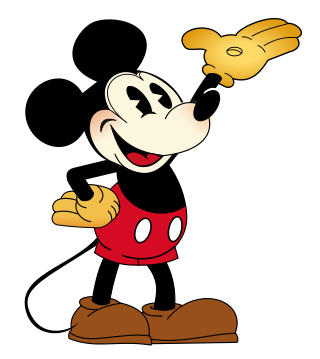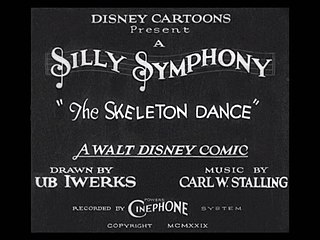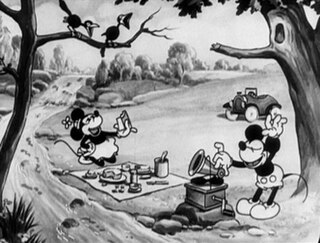
Mickey Mouse is an American cartoon character co-created in 1928 by Walt Disney and Ub Iwerks. The longtime icon and mascot of the Walt Disney Company, Mickey is an anthropomorphic mouse who typically wears red shorts, large shoes, and white gloves.

Oswald the Lucky Rabbit is an animated cartoon character created in 1927 by Walt Disney and Ub Iwerks for Universal Pictures. He starred in several animated short films released to theaters from 1927 to 1938. Twenty-seven animated Oswald shorts were produced at the Walt Disney Studio. After Universal took control of Oswald's character in 1928, Disney created a new character similar in appearance to Oswald as a replacement: Mickey Mouse, who went on to become one of the most famous cartoon characters in the world.

Mickey Mouse Works is an American animated television series produced by Walt Disney Television Animation featuring Mickey Mouse and his friends in a series of animated shorts. The first Disney television animated series to be produced in widescreen high definition, it is formatted as a variety show, with skits starring Mickey Mouse, Minnie Mouse, Donald Duck, Daisy Duck, Goofy, Pluto and Ludwig Von Drake while Horace Horsecollar, Clarabelle Cow, Morty and Ferdie Fieldmouse, Huey, Dewey and Louie, Chip 'n' Dale, Scrooge McDuck, Pete, Humphrey the Bear, J. Audubon Woodlore, Dinah the Dachshund, Butch the Bulldog, Mortimer Mouse, José Carioca, and Clara Cluck appear as supporting or minor characters. Musical themes for each character were composed by Stephen James Taylor with a live 12-piece band and extensive use of the fretless guitar to which the music of the series was nominated for an Annie Award in both 1999 and 2001. Most of the shorts from the series were later used in House of Mouse.

Plane Crazy is a 1928 American animated short film directed by Walt Disney and Ub Iwerks. The cartoon, released by the Walt Disney Studios, was the first appearance of Mickey Mouse and his girlfriend Minnie Mouse, and was originally a silent film. It was given a test screening to a theater audience on May 15, 1928, and an executive from Metro-Goldwyn-Mayer saw the film, but failed to pick up a distributor. Later that year, Disney released Mickey's first sound cartoon, Steamboat Willie, which was an enormous success; Plane Crazy was officially released as a sound cartoon on March 17, 1929. It was the fourth Mickey film to be given a wide release after Steamboat Willie, The Gallopin' Gaucho and The Barn Dance (1929).

Minerva "Minnie" Mouse is an American cartoon character created by the Walt Disney Company. As the longtime sweetheart of Mickey Mouse, she is an anthropomorphic mouse with white gloves, a red or pink bow, blue polka-dotted dress, white bloomers and low-heeled shoes occasionally with ribbons on them. The Mickey Mouse comic strip story "The Gleam" by Merrill De Maris and Floyd Gottfredson first gave her full name as Minerva Mouse, although this is seldom used.

Clarabelle Cow is a cartoon character created by The Walt Disney Company. As an anthropomorphic cow, Clarabelle is one of Minnie Mouse's best friends. She was once depicted as the girlfriend of Horace Horsecollar, although now she is often paired with Goofy.

The Mickey Mouse universe is a fictional shared universe which is the setting for stories involving Disney cartoon characters, including Mickey and Minnie Mouse, Donald and Daisy Duck, Pluto and Goofy as the primary members, and many other characters related to them, being most of them anthropomorphic animals. The universe originated from the Mickey Mouse animated short films produced by Disney starting in 1928, although its first consistent version was created by Floyd Gottfredson in the Mickey Mouse newspaper comic strip. Real-world versions also exist in Disneyland and Tokyo Disneyland, called Mickey's Toontown.

The Gallopin' Gaucho is a 1928 American animated short film and the second short film featuring Mickey Mouse to be produced, following Plane Crazy and preceding Steamboat Willie. The Disney studios completed the silent version in August 1928, but did not release it in order to work on Steamboat Willie. The Gallopin' Gaucho was released, with sound, after Steamboat Willie on December 30 of the same year.

The Skeleton Dance is a 1929 Silly Symphony animated short subject produced and directed by Walt Disney and animated by Ub Iwerks. In the film, four human skeletons dance and make music around a spooky graveyard—a modern film example of medieval European "danse macabre" imagery. It is the first entry in the Silly Symphony series. In 1993, to coincide with the opening of Mickey's Toontown in Disneyland, a shortened cover of the cartoon's music was arranged to be featured in the land's background ambiance. The short's copyright was renewed in 1957, and as a published work from 1929 it will enter the US public domain on January 1, 2025.

Wild Waves is a Mickey Mouse short animated film first released on December 18, 1929, as part of the Mickey Mouse film series. It was the fifteenth Mickey Mouse short to be produced, the twelfth of that year, as well as the last to be released by Celebrity Productions before Columbia Pictures took over distribution.

The Barn Dance is a Mickey Mouse short animated film first released on March 15, 1929, as part of the Mickey Mouse film series; it was the first of twelve shorts released during that year. It was directed by Walt Disney with Ub Iwerks as the head animator. The title is written as Barn Dance on the poster, while the full title is used on the title screen.

The Opry House is a 1929 Mickey Mouse short animated film released by Celebrity Pictures, as part of the Mickey Mouse film series. It was the fifth Mickey Mouse short to be released, the second of that year. It cast Mickey as the owner of a small theater. Mickey performs a vaudeville show all by himself. Acts include his impersonation of a snake charmer, his dressing in drag and performing a belly dance, his caricature of a Hasidic Jew and, for the finale, a piano performance of Hungarian Rhapsody No. 2 by Franz Liszt.

When the Cat's Away is a Mickey Mouse short animated film first released on May 3, 1929, as part of the Mickey Mouse film series. It was directed by Walt Disney and animated by Ub Iwerks and Ben Sharpsteen. It was the sixth Mickey Mouse short to be produced, the third of that year. In this cartoon, Mickey and Minnie are the size of regular mice, and Tom Cat is the size of a person.

Mickey's Choo-Choo is a 1929 Mickey Mouse short animated film released by Celebrity Pictures, as part of the Mickey Mouse film series. Ub Iwerks was the animator. It was the eleventh Mickey Mouse short to be produced, the eighth of that year, and was one of the series of early Disney cartoons that led Mickey Mouse to become a national fad by the end of 1929. Originally produced in black and white, this cartoon was one of 45 Mickey Mouse cartoons colorized by American Film Technologies in 1991.

Mickey's Follies is a Mickey Mouse animated short film first released on August 28, 1929, as part of the Mickey Mouse film series. It was directed by Ub Iwerks and Wilfred Jackson, with music by Carl Stalling. It was produced in black and white by The Walt Disney Studio and released to theaters by Celebrity Productions. It was the tenth Mickey Mouse short to be produced, the seventh of that year.

The Haunted House, also known as Haunted House, is a 1929 Mickey Mouse short animated film released by Celebrity Productions, as part of the Mickey Mouse film series. The cartoon was produced by Walt Disney Productions and distributed by Celebrity Productions. It was the fourteenth Mickey Mouse short to be produced, the eleventh of that year.

Traffic Troubles is a Mickey Mouse short animated film first released on March 7, 1931, as part of the Mickey Mouse film series. It was the twenty-sixth Mickey Mouse short to be produced, and the second of that year.

The Picnic is a 1930 American animated short film directed by Burt Gillett and produced by Walt Disney. It was first released on October 9, 1930, as part of the Mickey Mouse film series. It was the twenty-third Mickey Mouse short to be produced, the eighth of that year.

All Wet is a 1927 animated short subject film, produced by Charles Mintz and George Winkler and directed by Walt Disney. The film was reissued in 1932 by Walter Lantz Productions with added music and sound effects and is the only known version to survive. The short entered the public domain on January 1, 2023.




















